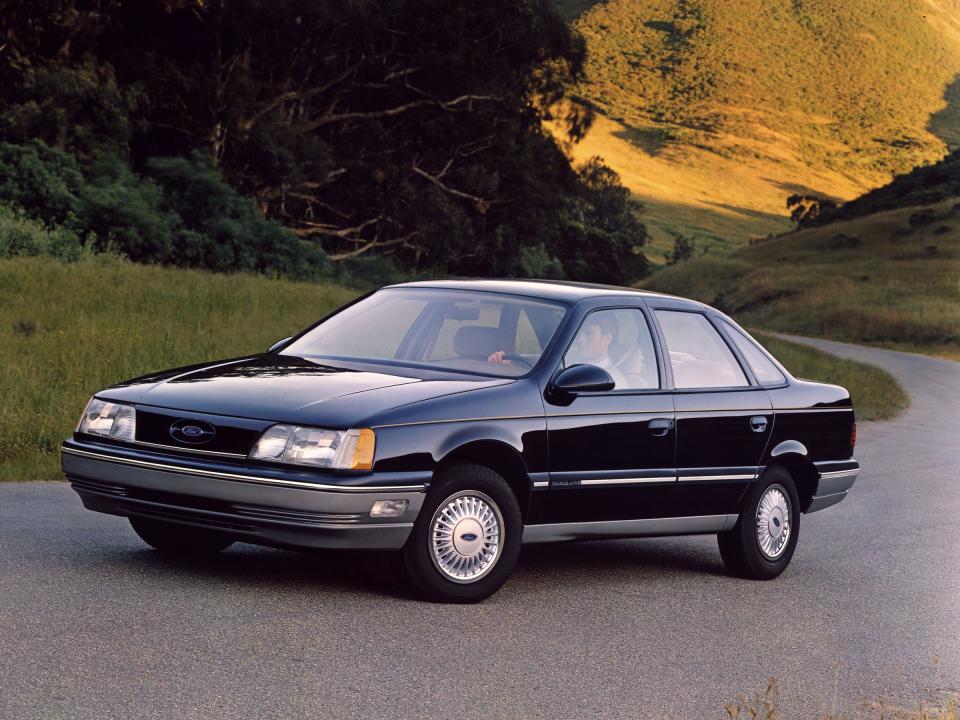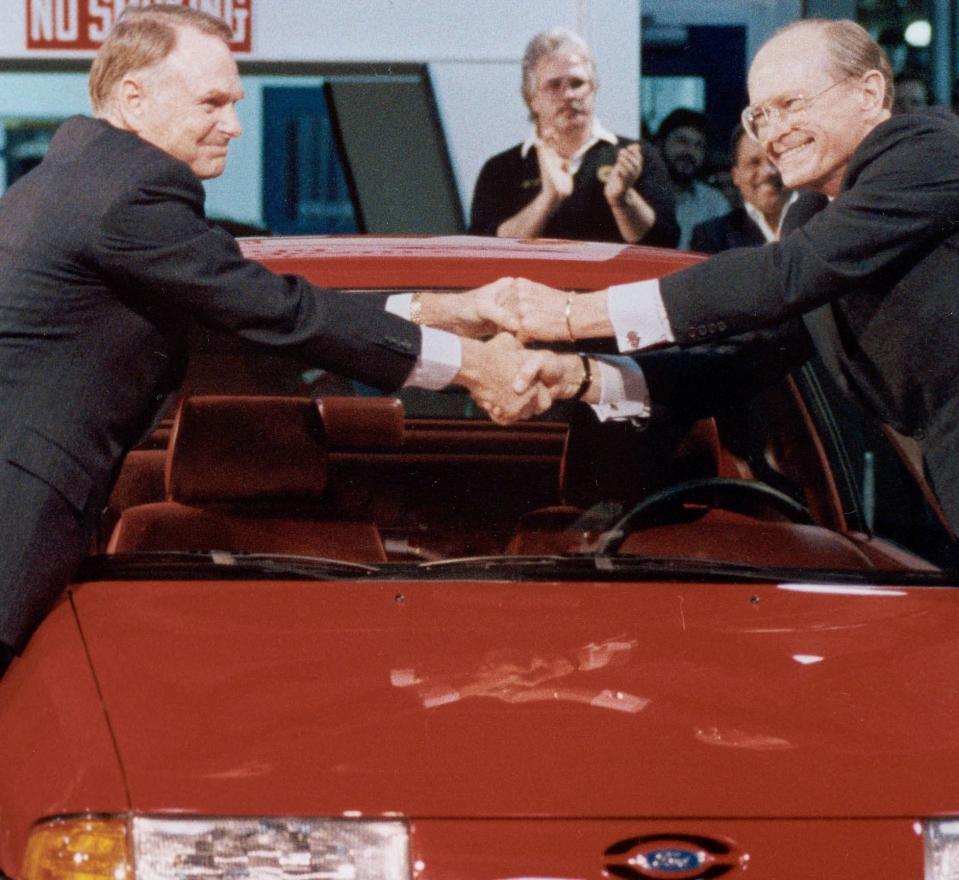Former Ford CEO Don Petersen, who spent 41 years with automaker, dies at 97
- Oops!Something went wrong.Please try again later.
- Oops!Something went wrong.Please try again later.
- Oops!Something went wrong.Please try again later.
Donald E. Petersen, the former Ford Motor Co. CEO whose visionary leadership won praise for saving the company in the 1980s, died Wednesday at his home in Bloomfield Hills at age 97, according to numerous reports citing a family member.
Petersen, a mechanical engineer and native of Pipestone, Minnesota, began at Ford in 1949 and left in 1990. He spent his last decade at the top — as chief operating officer from 1980-85, then chairman and CEO from 1985 to 1990.
His career was not without controversy, but he fought to improve the storied automaker and goes down in history as one of the most successful auto executives in history.
"He was a real change agent at Ford," said industry analyst John McElroy, host of "Autoline After Hours" webcast and podcast. "Don Petersen brought W. Edwards Deming into Ford, the guru of gurus of quality experts, and that had a transformational impact on Ford's quality. Deming really taught the Japanese how to make spectacular quality" using statistical analysis of the manufacturing process.
In addition, Petersen would talk about the need to "drive fear out of an organization," McElroy recalled, adding Peterson felt "management cannot treat itself as superior to the lowest person on the assembly line. You have to treat them as equals."
He rolled up his sleeves and worked with union
So Petersen got rid of executive parking spots and the dining room. "There was no executive nothing," McElroy said. "They couldn't be seen to have a superior position." And he sought input from the UAW.
“At one point, Peterson reached out to union leaders to figure out how to retool the glass plant at the Rouge to prevent those jobs from being transferred to another plant in the South,” McElroy said. “He laid out all the facts and figures and the UAW guys figured out how to come up with an all-new glass line using the skilled trades. They saved that plant.”
Petersen had a reputation for wearing no tie, no jacket, sleeves rolled up.
"They talked. They saved that operation by working together," McElroy said. "Petersen got all that from Deming."
Ford Motor Co., in a statement provided by spokesman Ian Thibodeau, said, "Donald Petersen was a steadfast leader during an important part of Ford’s history. He insisted on teamwork and excellence in the name of customers, and guided Ford through a period of revitalization and intense competition in the global auto industry. Donald pushed his teams to design and deliver vehicles they’d be proud to park in their own driveways, a standard to which we still hold ourselves. Our thoughts and prayers are with Donald’s family during this sad time."
Ford responded to news media inquiries but said it did not have independent confirmation of the Petersen death.
Quality issues, unresolved after his exit, haunt Ford now
When Ford CEO Jim Farley assumed leadership of the automaker in October 2020 with the departure of Jim Hackett, quality issues and the costs associated with recalls and warranty repairs were spiking and among the worst in the industry. In February, Farley said he regretted not focusing attention on production improvements sooner. This month, Farley and CFO John Lawler said during a first-quarter earnings call with industry analysts that the delayed launch of the 2024 F-150 was for quality review protocols. Farley has vowed to change the schedule in order to identify and reduce quality problems, he said.
Ford earned a strong reputation for working collaboratively with the UAW under Petersen's leadership. Former UAW President Rory Gamble provided a statement to the Detroit Free Press praising the executive:
“For UAW retirees and members, Don Petersen’s tenure was a transformative time for Ford," Gamble said. "His relationship with UAW members was respectful and the company launched trendy products like the Taurus and Thunderbird that became iconic vehicles in their generation." He "created a true sense of pride and craftsmanship for UAW Ford members in their work.”
'From the edge of financial disaster'
Petersen topped high-profile rival Lee Iacocca at Chrysler and GE's Jack Welch as the most effective business leader in a Fortune 500/CNN Moneyline CEO poll of executives, Fortune reported in October 1988 as "a bit of a surprise." After Petersen, Iacocca and Welch, the rest were also-rans, the poll indicated.
A year later, The New York Times referred to Petersen as the executive who helped bring Ford "from the edge of financial disaster to a ranking as the most profitable of the Big Three automakers."
His alma mater, the University of Washington, noted his being named “Most Valuable Person” of 1988 by USA TODAY and “CEO of the Year” by Chief Executive magazine in 1989, for transforming Ford "with his inclusive, team-oriented management style."

Petersen left Ford abruptly. He had been "slated to retire in September 1991 when he turned 65 but instead retired about 18 months early, partly for personal and family reasons," United Press International reported Nov. 10, 1989.
Reports at the time suggested he alienated the Ford family with his view on the roles Bill Ford Jr. and Edsel Ford II would play after the death of Henry Ford II in 1987.
While Petersen admired the young and relatively inexperienced Ford men, he told Fortune magazine in January 1989, "being a Ford does not give them a leg up. The principle we must operate on is that selection to top management is based solely on merit.”
He considered quitting, and didn't
When Petersen retired in March 1990, Fortune said at the time, "he will have been Ford's most successful boss since the original Henry in his prime."
But it wasn't easy.
"Discouraged by the corrosive politics of climbing the corporate ladder, Petersen had considered quitting several times," the Los Angeles Times reported on March 10, 1996. "Ford’s steep dive in sales — and a net loss of $1.5 billion in 1980 — provided him the rationale for attempting to reshape corporate culture as a way to encourage better performance."
The company's focus on loyalty over performance did little to nurture innovation or creativity or even encourage workers to discuss problems that required solutions, whether in the factory or at Ford World Headquarters, Petersen observed at the time.
"Workers, quite simply, were afraid of offending their bosses. A manager’s status was measured according to the number of people under his or her supervision. Managers competed fiercely among themselves for promotions; their subordinates were expected to display loyalty to the chief," the Los Angeles Times wrote in a profile of Petersen in 1996. "To outdo their peers, managers withheld information from rivals and prohibited subordinates from cooperating with members of competitive departments, a practice that inevitably led to design errors, delays and cost overruns."
Petersen's battle to break down old ways eventually led to the groundbreaking redesign of the sleek Thunderbird.
Ford beats GM
Peterson's 1991 book, "A Better Idea: Redefining the Way Americans Work," published by Houghton Mifflin Harcourt, depicts executives giving power to employees.
People listened to Petersen because he knew how to make money.
During Petersen's decade at the top, "Ford's U.S. market share rose from 17% to 22%," Fortune said on Dec. 18, 1989. "Petersen emphasized teamwork and long-term strategic thinking. By directing development of the jellybean-shaped, front-wheel-drive Taurus, he ignited Ford's recovery. He says Ford's 1989 model quality — measured by defects that customers notice — is 66% better than in 1980."

Success under Petersen won Ford recognition from industry analysts and shareholders.
"How CEO Donald Petersen Turned Third-Ranked Ford Into a Sales Powerhouse" was the headline of a "miracle story" in Selling Power magazine, Feb. 2, 2010."Ford Motor Company’s painful cost-cutting of the early 1980s, which included massive layoffs and plant closings paid off. ... For two consecutive years — 1986 and 1987 — Ford earned more money than its giant rival, GM. It marked the first time since 1924 that Ford beat GM’s profits," wrote Michelle Krebs, who recently retired as executive analyst at Autotrader.
Petersen was inducted into the Automotive Hall of Fame, along with automotive designer and race car driver Carroll Shelby, in 1992. The induction biography said, "Like all U.S. car makers, Ford had lost substantial sales to foreign manufacturers that were building higher quality, smaller and more fuel-efficient vehicles. Petersen pushed for better products with stronger customer appeal, emphasizing the development of smaller, more efficient cars."
Petersen, a U.S. Marine who earned a bachelor of science degree in mechanical engineering at the University of Washington between service in World War II and the Korean War, later earned an MBA from Stanford University.
Ford named then-chief operating officer Harold A. "Red" Poling, 64, as Petersen's successor for a three-year term as CEO. Poling died in 2012 at age 86.

He served on a number of boards of directors, including Dow Jones & Co, Unilever, Hewlett-Packard and The Boeing Co., where he first met an engineer named Alan Mulally. Ford hired Mulally to succeed Bill Ford as CEO from 2006 to 2014. Ford, the great-grandson of the company founder, became executive chairman. Bill Ford remains executive chair of the board today.
"Though he was part of the teams that launched the Ford Thunderbird and Mustang, Petersen's real fame is rooted in his revival of the Ford dynasty in the 1980s," according to the Harvard Business School's Great American Business Leaders of the 20th Century page. "Under Petersen's leadership, Ford grew out of the shadow of GM, redesigning the Thunderbird, and launching the Taurus and Mercury Sable; cars that became symbolic of the American family."
Free Press staff writer Mark Phelan contributed to this report.
Contact Phoebe Wall Howard: 313-222-6512 or phoward@freepress.com. Follow her on Twitter @phoebesaid. Read more on Ford and sign up for our autos newsletter.
This article originally appeared on Detroit Free Press: Ex-Ford CEO Don Petersen dies at 97

